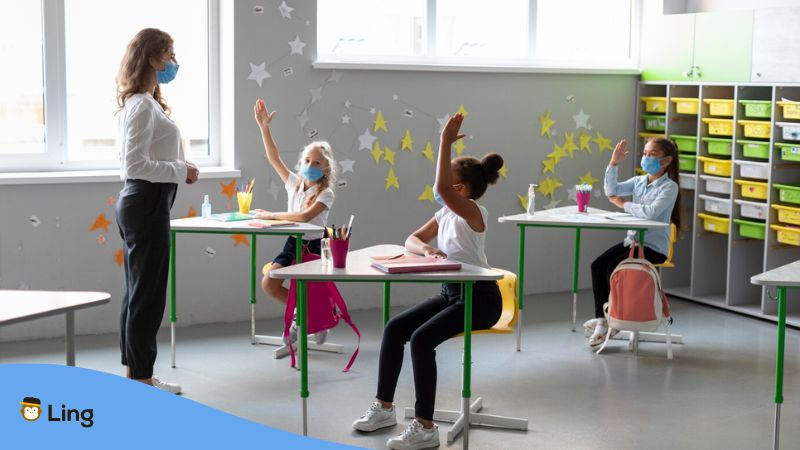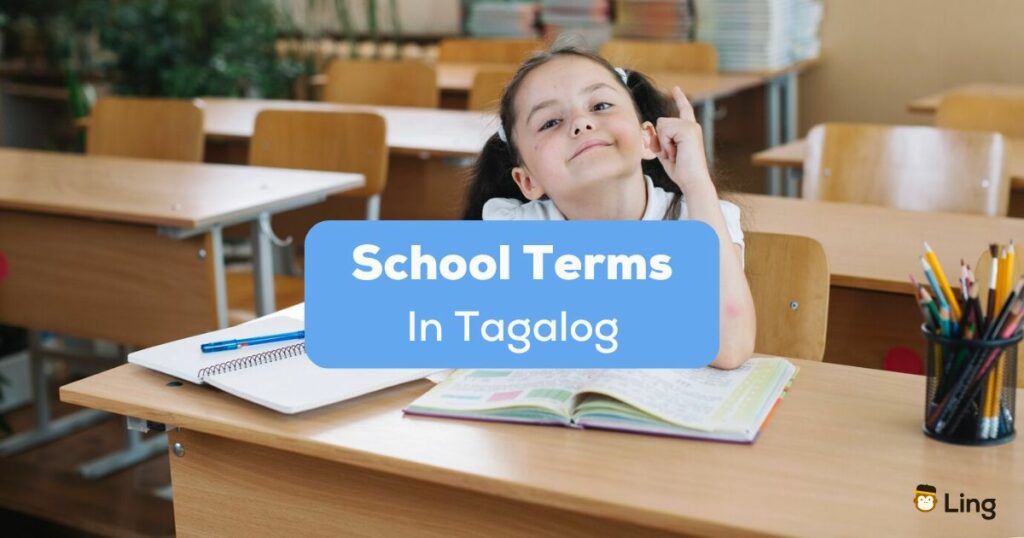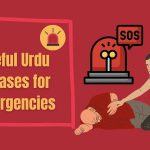Do you want to know what students in the Philippines talk about? Do you want to impress your Filipino friends or just sound like a total language genius? Well, we’ve got your back! In this post, we’ll reveal all the easiest school terms in Tagalog that fill Filipino classrooms.
With this vocabulary, you can easily navigate through daily conversations, bond over common experiences, and immerse yourself fully in Filipino student life. Let’s get started!
Table Of Contents
What’s It Like Inside A Filipino School?
So, picture this: You’re strolling through the corridors of a lively Filipino school (paaralan), feeling the buzz of excitement in the air. You pass by some students scribbling furiously, teachers (mga guro) dropping knowledge bombs left and right, and colorful posters screaming inspiration from the walls. It’s like entering a language wonderland, my friend!
Now, imagine being able to crack the code of this linguistic adventure and join in on the action. From desks and chairs to pens and notebooks, we’re diving deep into the world of school objects. But wait, there’s more! We’ll also explore the verbs, phrases, and adjectives that’ll make you the talk of the campus.
Think of it as your backstage pass to the Filipino education scene. With these Tagalog school words in your arsenal, you’ll be impressing everyone with your mad language skills faster than you can say, “Kamusta ka?”
Oh, and here’s the best part: Learning Tagalog school words isn’t just about sounding cool—it’s about understanding a culture, connecting with people, and expanding your horizons. So get ready to soak up the Filipino vibes, my friend, because we’ll take you on a language rollercoaster you won’t want to get off!
Ready to rock the Tagalog classroom? Awesome! Grab your backpack, put on your thinking cap, and let’s dive headfirst into the awesome world of Tagalog school words. Buckle up, folks—this linguistic adventure is about to blow your mind!
Easiest Tagalog School Words For Beginners
Are you ready to breeze through your Tagalog language journey with some easy yet essential school words? In this section, we’ll introduce you to a selection of straightforward vocabulary that will have you impressing your Filipino friends ASAP.
Classroom Objects And Furniture
Desk – Lamesa
Whether you’re sitting solo or partnering up for group work, the trusty lamesa will be your study companion.
- Ang lamesa ay malaki. = The table is big.
- Sa lamesa kami kumain. = We ate at the table.
Chair – Upuan
Pull up a chair, my friend! The upuan is where you’ll plant yourself for hours of learning and collaboration.
- Wala na akong upuan. = I have no more chair to sit to.
- Bibili ako ng upuan. = I will purchase a chair.
Blackboard – Pisara
Watch out for that cloud of chalk dust as you scribble away on the pisara, the traditional blackboard where teachers work their magic.
- Nagsulat ako sa pisara. = I scribbled on the blackboard.
- Binura ko ang sulat sa pisara. = I erased the writings on the blackboard.
Bookshelf – Estante ng mga Aklat
Do you need to grab a book for some serious studying? Look no further than the estante ng mga aklat, a treasure trove of knowledge.
- Pakikuha ang libro sa estante ng mga aklat. = Please get the book from the bookshelf.
- Nasa estante ng mga aklat ang iyong hinahanap. = The book you’re looking for is on the bookshelf.
Eraser – Pambura
Oops! Did you make a mistake? It’s time to reach for your trusty pambura and wipe away those pencil marks.
- Pakibura mo nga ito gamit ang pambura. = Please erase this using the eraser.
- May pambura ka ba? = Do you have an eraser?
Writing And Stationery Items
Pen – Panulat
When taking notes or unleashing your creative side, a reliable panulat is a must-have tool.
- Puwede makahiram ng panulat? = May I borrow a pen?
- Wala ng tinta ang aking panulat. = My pen doesn’t have ink.
Pencil – Lapis
Do you need to fill in those bubble sheets or sketch your next masterpiece? The versatile lapis has you covered.
- Mapurol na ang aking lapis. = My pencil is blunt.
- Bumili ako ng bagong lapis. = I bought a new pencil.
Notebook – Kwaderno
Your personal hub of knowledge, the kwaderno is where you’ll record your thoughts, ideas, and epic doodles.
- Isulat mo ito sa iyong kwaderno. = Write this in your notebook.
- Nawawala ang aking kwaderno. = My notebook is missing.
Scissors – Gunting
From arts and crafts projects to cutting out important study materials, the gunting is your go-to cutting companion.
- Puwede ba makahiram ng gunting mo? = Can I borrow your scissors?
- Mag-ingat sa paggamit ng gunting. = Be careful when using scissors.
School Subjects And Areas Of Study
Mathematics – Matematika / Sipnayan
Get your brain cells fired up for some exciting problem-solving adventures in the realm of matematika/sipnayan.
- Hindi ako magaling sa matematika/sipnayan. = I am not good in mathematics.
- Magaling si Jon sa matematika/sipnayan. = Jon excels in mathematics.
Science – Agham
Prepare to be amazed by the wonders of the natural world as you delve into the realm of agham.
- Ayoko sa mga usapin tungkol sa agham. = I do not want conversations related to science.
- Sana ay tumaas ang aking grado sa agham. = I hope my grades in Science will be better.
History – Kasaysayan
Time to travel back in time! Kasaysayan will take you on a journey through the rich tapestry of past events.
- Lahat ng ito ay nakatala sa kasaysayan. = All of these are recorded in history.
- Tayo na’t alamin ang kasaysayan. = Let’s explore the history.
Geography – Heograpiya
Explore the world from the comfort of your classroom with heograpiya, where you’ll learn about lands near and far.
- Mag-aral tayo ng heograpiya. = Let’s study geography.
- Hindi ako magaling sa heograpiya. = I am not good in geography.
Physical Education – Edukasyong Pisikal
Time to get moving and break a sweat! Edukasyong Pisikal is where you’ll unleash your inner athlete.
- Maganda sa katawan ang Edukasyong Pisikal. = Physical Education is good for the body.
- Maraming matututunan sa Edukasyong Pisikal. = There’s a lot to learn in Physical Education.
Get familiar with these basic Tagalog school words, and you’ll be well-equipped to tackle any classroom adventure that comes your way. So grab your lamesa, settle into your upuan, and let the learning continue!
And if you want to learn more about the Tagalog language, you can try the Ling app. It’s a fun language app, effective, free, and easy way to learn new languages! You can get the app from Google Play and App Store and start having fun while mastering new languages!

School-Related Actions And Verbs
Now that you’re familiar with the essential school objects, let’s dive into the exciting realm of school-related actions and verbs in Tagalog. These words will help you navigate classroom interactions, express yourself, and engage in the educational experience. Get ready to expand your vocabulary and rock the school scene!
Common Verbs Used In School Settings
To Study – Mag-aral
Time to hit the books! Mag-aral is the verb that encapsulates studying and acquiring knowledge.
- Mag-aral ka nang mabuti anak. = Study well, my child.
- Mahirap mag-aral kapag walang gana. = It’s difficult to study without motivation.
To Learn – Matuto
Every day is an opportunity to matuto, to gain new insights, and expand your intellectual horizons.
- Pursigido siyang matuto. = She is determined to learn.
- Gusto niyang matuto mag gitara. = He wanted to learn how to play the guitar.
To Write – Sumulat
Whether it’s taking notes, writing Tagalog essays, or jotting down your thoughts, sumulat is the Tagalog verb that represents the act of writing.
- Si Gen ay sumulat ng liham para kay Jon. = Gen wrote a letter for Jon.
- Marunong nang sumulat si Joe Ben. = Joe Ben now knows how to write.
To Read – Magbasa
Grab a book, a newspaper, or a thrilling story, and get ready to basa (root word of magbasa) your way into new worlds and ideas.
- Magbasa ka na ng iyong libro. = Read your book now.
- Mahilig siyang magbasa ng komiks. = He enjoyes reading comics.
To Listen – Makinig
Attentiveness is key in the classroom. Makinig is the verb that captures the act of actively listening and absorbing information.
- Lahat ng kanyang mga estudyante ay marunong makinig. = All of his/her students know how to listen.
- Makinig ka ng mabuti. = Listen carefully.
Actions Performed By Students And Teachers
To Teach – Magturo
Teachers play a vital role in our educational journey. They teach us valuable lessons and skills. So for all the teachers out there, magturo lang tayo para sa kinabukasan (let’s teach for the future).
- Magaling siyang magturo. = She teaches well.
- Hilig niya ang magturo ng mga direksyon. = He likes to teach directions.
To Ask – Magtanong
Curiosity fuels the learning process. When you have a question or need clarification, don’t hesitate to magtanong.
- Huwag kang mahihiyang magtanong. = Don’t be shy to ask.
- Puwede ka magtanong sa akin. = You can ask me.
To Answer – Sumagot
Speaking up and providing responses is an important part of classroom interaction. Sumagot when the teacher calls on you or when engaged in discussions.
- Si Jon ay sumagot ng pabalang. = Jon answered sarcastically.
- Huwag kang sumagot kapag hindi ikaw ang kausap. = Don’t answer if you’re not the one being spoken to.
To Raise hand – Itaas ang kamay
When you have something to say or a question to ask, the polite way to get the teacher’s attention is to itaas ang kamay or raise your hand.
- Kung may nais kang itanong, itaas mo ang iyong kamay. = If you have a question, raise your hand.
- Maari mo bang itaas ang iyong kamay. = Can you please raise your hand?
By familiarizing yourself with these Tagalog school-related actions and verbs, you can actively participate in classroom activities, engage with your peers, and make the most of your educational journey. So, get ready to mag-aral, sumulat, and magtanong your way to academic success!
Other School-Related Terms To Know Plus Great Examples
Now that you’re more familiar with the Philippines and the school system within the Philippines, it’s time to talk about essential school terms! Get your notebook or tablet out and start taking some notes! We’ve included the English word with the corresponding Tagalog word for your convenience.
General Terms
Here’s a table with some cool school words in English and their Tagalog counterparts. It’s your cheat sheet for chatting like a champ at school.
School Supplies
Diving into school means you’ll need the right gear. Check out these must-have school supplies in Tagalog, from the bag on your back to the pen in your hand. Here’s how you say them and a sneak peek at how they sound.
Example Sentences
Ready to start talking like you’re already part of a Filipino classroom? These example sentences will help you ask questions and share information with your friends in Tagalog. It’s like having a conversation starter pack!
Tagalog Phrases For Parent-Teacher Interactions
Ok, now what if you’re a parent or a guardian trying to bridge the language gap at those all-important parent-teacher meetings? No worries! We’ve got you covered with these Tagalog phrases for smooth communication.
Whether you’re aiming to express concerns, ask about your child’s progress, or simply get more involved, these phrases are your key to unlocking meaningful conversations. Dive in and use these gems at your next meeting or chat to show just how invested you are in your child’s educational journey.
Empower yourself with these phrases, and you’ll enhance your ability to participate in your child’s education. Not only that, but you’ll also demonstrate your support and commitment to their academic success!

The Philippines: Quick Facts
If you want to travel to the Pearl of the Orient Sea for whatever reason, we highly recommend that you get acquainted with some of the specifics related to this awesome country. To help you get started, we added here brief facts about the Philippines and where exactly it is located on the map.
Make sure to remember these facts and any additional research you do on your own to impress the locals even more! Here’s the must-know facts for every traveler visiting the Philippines for the first time:
- Location: Southeast Asia (archipelagic country)
- Capital: Manila
- Largest City: Quezon City
- Population: Approximately 118 million (As of 2024)
- Official Languages: Filipino, English
- Currency: Philippine peso ($1.00 = 55.85 Philippine pesos)
- Number of Islands: 7,641
- Maritime Borders: Taiwan (north), Japan (northeast), Palau (east and southeast), Indonesia (south), Malaysia (southwest), Vietnam (west), China (northwest)
School Holidays In The Philippines
If you’re studying or living in the Philippines, you should know all the national and school holidays. To make things easier for you, we’ve already created a list of some of the major holidays in the Philippines!
| Holiday | Date |
|---|---|
| Lunar New Year | February 10 |
| People Power Anniversary | February 25 |
| Day of Valor | April 9 |
| Maundy Thursday | March 28 |
| Good Friday | March 29 |
| Labor Day | May 1 |
| Eidul-Fitr Holiday | TBD |
| Independence Day | June 12 |
| Feast of the Sacrifice (Eid al-Adha) | TBD |
| Ninoy Aquino Day | August 21 |
| National Heroes Day | August 26 |
| All Saints’ Day | November 1 |
| Bonifacio Day | November 30 |
| Feast of the Immaculate Conception | December 8 |
Remember that these dates can change each year, but, in general, the holiday will fall around the date provided above. It’s similar to how Thanksgiving (US) is celebrated on different dates every year, yet it still takes place around the same time.
You Are Now Ready For School Conversations!
Now that you’ve expanded your Tagalog school vocabulary, you’re one step closer to navigating the exciting world of Filipino education. These school terms in Tagalog will come in handy whether you’re chatting with students, understanding school announcements, or helping your own child with homework. And remember, language learning is an ongoing journey—keep exploring, keep practicing, and you’ll be fluent in no time!
Updated By: Jefbeck



































































